
There are over 40 types of orange flowers, each of which is known for being bright and bold. An orange flower’s flame-like colorations often symbolize passion, excitement, and regrowth. Come with me as I discuss unique orange flowers available worldwide and fun facts about each of them.
1. Pansy
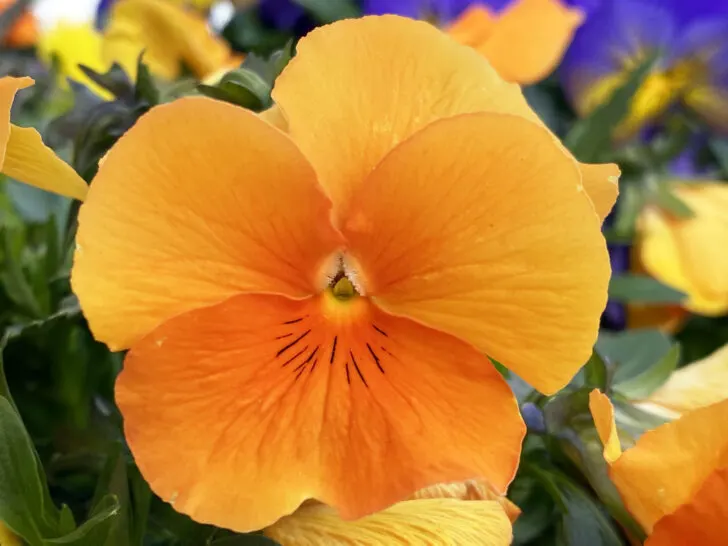
The orange pansy (Viola X Wittrockiana) is a stunning flower, though the orange variation isn’t as common. Pansies originated in Iver, Buckinghamshire, England, in the 1800s when a lord and his gardener began crossing Viola flower species.
These beautiful flowers typically appear in the spring and tolerate warmer temperatures. The pansy flower also symbolizes joy, happiness, and optimism. Additionally, the plants produce large flowers, though the plant only reaches a little over 8 inches (20 cm) in height.
2. Lantana
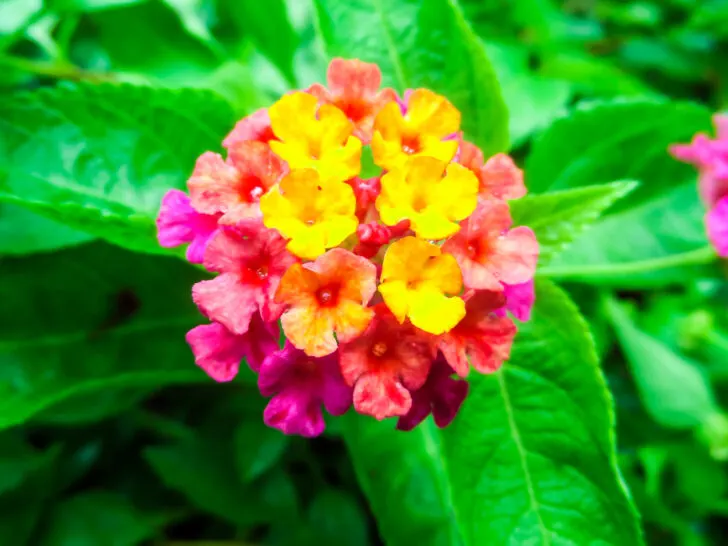
Lantanas are relatively low-maintenance flowers known for their extended bloom times. These vibrant perennials come in various shades and colors, including orange. A unique thing about lantanas is how the flowers sit tightly in a bouquet-like grouping.
These flowers can be grown year-round in warmer climates and are native to Central and South America. However, it’s also important to note that the hairs on the lantana leaves can cause skin irritation, so it’s best to avoid touching them.
Additionally, the plant is considered toxic and should not be consumed.
3. Lily

Lilium Bulbiferum, or the orange lily name, is derived from the Latin word lilium. The lily flower has long been a symbol of purity and innocence. This stunning flower thrives in the southern United States, though native to Europe.
The lily flower typically grows during the summer months, May-July. Lilies can also reach 2-4 ft (60-121 cm) in height. Additionally, the orange lily is known for its vibrant orange coloration and is often referred to as a Fire Lily.
4. Emperor Tulip

Another pretty orange flower is the Emperor Tulip. This flower typically comes in paler shades of orange with darker colorations along the petal tips. The plant blooms in the early spring but needs planting before the last frost sprouts.
The orange tulip symbolizes a sense of warmth, appreciation, and understanding between two people. These flowers are often given as a gift, signifying the connection between a couple. The Emperor Tulip descends from a wild variety of tulip originated in Central Asia.
5. Poppy

The orange poppy, also known as the Prince of Orange, has thin, delicate flower petals surrounding a chocolate center. These flowers are incredibly tolerant to cold weather and grow well from spring-summer. The flower is also native to Central Asia.
This perennial is incredibly popular in areas with many deer and rabbits, as it’s a hardy plant. The orange poppy is also a favorite of the local birds, especially hummingbirds. The poppy flower also attracts many good insects like butterflies and ladybugs.
6. Calendula

This annual flower is a member of the daisy family and is known for its thin yet dense array of orange petals. These vibrant flowers are native to southwestern Asia, western Europe, Macaronesia, and the Mediterranean.
Calendula is a flowering herb historically used for medicines and in culinary dishes. The petals are sought after for the spicy, almost saffron flavor they added to dishes. While medicinally, the plant was used to improve the immune system.
7. Trumpet Vine
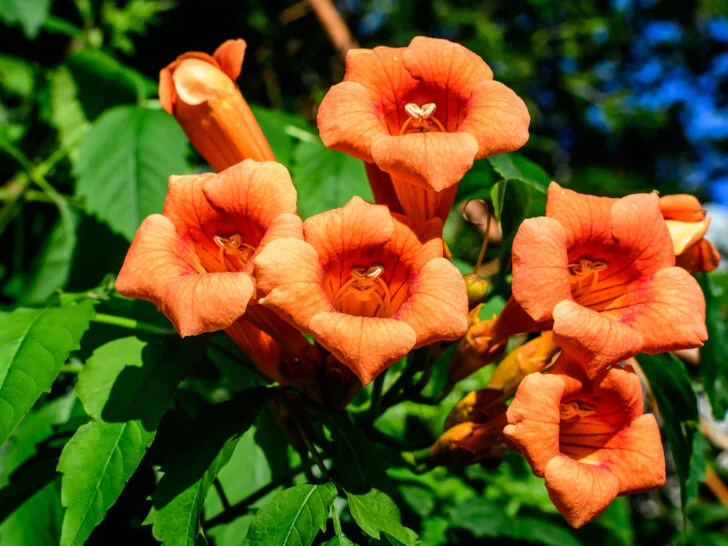
Campsis, or the Trumpet vine, is a plant that creeps along the ground and nearby structures. It’s famous for its ability to climb lattices, fences, and even homes. In addition, the flowers have a strong sweet smell perfect for attracting beautiful birds like hummingbirds.
Though the perennial vine is considered invasive, many gardeners purposely seek out the plant. The Trumpet Vine originated in China and North America. The plant has since migrated to gardens all over the world.
Typically, the vine is used to create privacy or to attract vibrant birds and bugs. In addition, the flowers give off a desirable sweet fragrance.
8. Blanket Flower

The blanket flower or Gaillardia looks similar to a daisy. However, the flowers’ colorations are typically deep orange with yellow-tipped petals. The name Blanket Flower is derived from how these plants spread like a blanket across the land.
Gaillardia is considered a herbaceous perennial. The vibrant plants prefer being planted in full sun. As a result, the plants repeatedly bloom throughout the summer and fall. However, blanket flowers are highly susceptible to plant-borne illnesses.
Blanket flowers are cultivated hybrids, though they descend from North American wildflowers. It’s important to note that the blanket flower is slightly toxic to humans. However, the flowers do make a great beginner plant for gardening.
9. Bird of Paradise

This unique flower is named after its ability to mimic a tropical bird. Visually, the vibrant orange flowers look like a bird in flight sniffing a plant. In addition, the flower has sweet nectar that attracts animals like hummingbirds.
This perennial is considered hardy and drought resistant. The bird of paradise originates in South Africa but is prevalent in many tropical regions. The stunning plant can also be grown indoors in cooler climates.
The orange variety of this plant has declined over the years due to limited pollinators. Therefore, the flower is considered vulnerable.
10. Dahlia

Dense, colorful spade-shaped petals and rounded bulbs are the tell-tale sign of a dahlia. In addition, this stunning plant comes in several shades of orange. Dahlias generally flower from late August to early October.
The orange dahlia typically reaches 20-30 inches (50-76 cm) in height. The tall plants are great for varying heights in a garden. The flowers also add to bouquets and are therefore popular amongst florists.
Dahlias are native to Mexico and Central America. However, plants are now trendy in the United States. The flower symbolizes beauty, commitment, and kindness. In addition, plants are known for being resilient due to their ability to grow when other plants die.
11. Daylily

Daylilies are considered low-maintenance flowers. The plants also produce large drought-resistant blooms. These lilies are native to Asia and made their way to Europe in the 1800s.
The daylily isn’t considered a true lily. The flower belongs to a genus of flowers known as Hemerocallis. The name means beauty in Greek, which is fitting for the flower.
Each flower only lives a single day, thus the name daylily. Visually, the daylily varies by having clumps of multiple stems from which flowers bloom. In contrast, a true Lily has a single stem per flower.
12. Marigold

Marigolds, often referred to as hero orange, are one of the most commonly grown orange flowers. The French marigold is a popular plant for brightening up any garden space. However, the flowers are sensitive to water, easily rotting from plunged moisture.
The orange marigold, or Tagetes Erecta, signifies passion, positive energy, and intense emotions. Marigolds have romantic connotations when it comes to gifting them. The flowers are pretty pest resistant and make great companion plants because of this.
The bright petals of the marigold flowers are used to lead souls during Mexico’s Day of the Dead holiday. Aztecs also consider these beautiful flowers to be sacred. Additionally, the stunning flowers are often known as the “herb of the sun.”
13. Hibiscus

The orange hibiscus is a large tropical flower that is thought to have originated in China, Japan, and the Pacific islands. Orange hibiscus is often referred to as the Chinese hibiscus or the shoeblackplant. This stunning shrub has been cultivated for hundreds of years, slowly spreading to other climates.
Hummingbirds and other pollinators are attracted to these stunning flowers. The plant prefers to live in full sunlight. Additionally, the bright flowers give off an intense floral aroma.
Orange hibiscus flowers signify healing and vitality. Plants are also generally associated with luck, happiness, and sunlight. Hibiscus goes dormant during cooler weather and returns each year.
14. California Poppy

Unlike regular poppy plants, the California poppy contains no opiates or addictive properties. This poppy is considered a wildflower, as it grows naturally in California. The orange flowers favor the Pacific coast and can be seen in full bloom during the spring and summer.
Despite the flowers’ stunning shape and colors, it’s toxic to humans and animals. Though the plants are generally wild-grown, many gardeners enjoy adding them to their flower gardens. These hardy plants grow easily and require little care in terms of fertilization.
The California poppy is the state flower of California (the golden state). Aptly, the flower acts as a floral representation of the state’s gold rush. These flowers are often referred to as fields of gold due to their bright colors.
15. Cigar Plant

Cuphea Ignea, or the cigar plant, has a unique shape, which it’s so aptly named after. The long orange perennial flowers appear slightly burnt on their end, much like a cigar. Though technically a shrub, the cigar plant can grow 12-18 inches (30-45 cm) tall.
The plants are known for the mass of blooms they produce during the warm summer months. Cigar plants originate from Mexico and the West Indies. However, cigar plants also grow well in more temperate climates in the US and parts of Europe.
The plant’s scientific name descends from Latin, its name meaning fire. As for symbolism, the plant signifies respect and affection.
16. Frangipani

Though this flower comes in various colors, the orange variation is one of the most stunning. The flowers are typically dark orange toward the center, getting lighter toward the petal tips. Frangipani grows in groups of three blooms along the tree’s foliage.
These vibrant trees are considered rare. However, exotic plant collectors enjoy adding these beautiful trees to their gardens. That being said, the flowers are still relatively easy to grow.
Additionally, these plants are pretty vibrant, but the petals tend to bleach in the sun. So if you want them to stay dark orange, they will need partial sun. Finally, this coloration of frangipani is relatively new, having first been cultivated in 2014.
17. Gerbera Daisy

These large daisies are native to South Africa and were first discovered in 1727. The gerbera daisy is a relative to marigolds and sunflowers. Though these daisies come in various colors, the bright orange ones are a favorite.
The herbaceous perennial thrives in sunlight but isn’t tolerant of extreme heat. Gerbera daisies are repeat bloomers and require regular pruning/deadheading. However, this plant grows best in gardening zones 8-10.
Symbolism-wise, the gerbera daisy signifies the beauty of living a happy life. Generally, these flowers are grown for decorative purposes. However, they also make a regular appearance in home garden beds.
18. Lion’s Tail

Originating in South Africa, this giant shrub is known for its vibrant orange spray flowers. Lion’s tail, also known as lion’s ear, is technically a member of the mint family. The plant is easy to grow and does well in most gardening zones.
However, In warmer climates like California, lion’s tail can bloom all year round. The plant is a drought restaurant and does well in extreme heat. The plant’s unique flowers attract an array of pollinators and are great for the bees.
Height-wise, lion’s tail is tall, reaching 4-6 ft (120-180 cm).
19. Persian Buttercup

Ranunculus Asiaticus, also known as the Persian buttercup, are round rose-like flowers. The beautiful orange flowers prefer blooming in cool spring weather. However, the plants don’t tolerate heat and go dormant during summer.
The Persian buttercup hails from the eastern Mediterranean, Southeastern Europe, and Northeastern Africa. Symbolism-wise, the flower signifies charm and interest. Typically, buttercups are gifted as gifts to a crush.
Additionally, the flowers are toxic in large quantities if eaten. Unfortunately, the buttercups are sensitive to infestations and illness. However, with proper prevention steps, bugs won’t be a problem.
20. Red Hot Pokers

Red hot pokers or torch lilies are perfectly named for their similar appearance to a hot poker or torch. The unique plant is native to Africa, though the plant grows well in gardening zones 6-9 during the spring and summer. These large plants require plenty of space to flower and grow.
Torch Lilies are extremely sensitive to overwatering and require well-draining soil. Without good drainage, they will easily develop root rot and die. Additionally, though the plants aren’t considered poisonous, consuming them isn’t recommended.
Eating large amounts of Red Hot Poker flowers will result in kidney stones.
21. Rose

There are several varieties of orange roses, ranging from dark to light shades. Ambridge rose, port sunlight, and tamora roses are the most popular orange roses. The orange rose was cultivated to increase the sales of the plant.
In the 1900s, the orange rose was born by mixing red and yellow roses. The orange rose signifies a passionate, fiery desire. Additionally, they are a popular Halloween decor addition due to their pumpkin-like color.
Since its creation, the orange rose has gained much popularity. Now, these flowers are found in stores and gardens worldwide. The sunset-colored flowers, though stunning, are less expensive than their sibling red rose.
22. Snapdragon

The snapdragon is another popular orange flower. Snapdragons come in an array of colors, including peach and orange. Additionally, snapdragons are used in culinary creations like garnish for salads, drinks, or desserts.
Summer is the snapdragon’s preferred growing season. The annual flowers pop up to flower yearly. The seed pods spread quickly and can easily take over a garden like a weed if not monitored.
Snapdragons are great for attracting pollinators like bees and hummingbirds. Plus, the plants do a great job adding a pop of color.
23. Coneflower
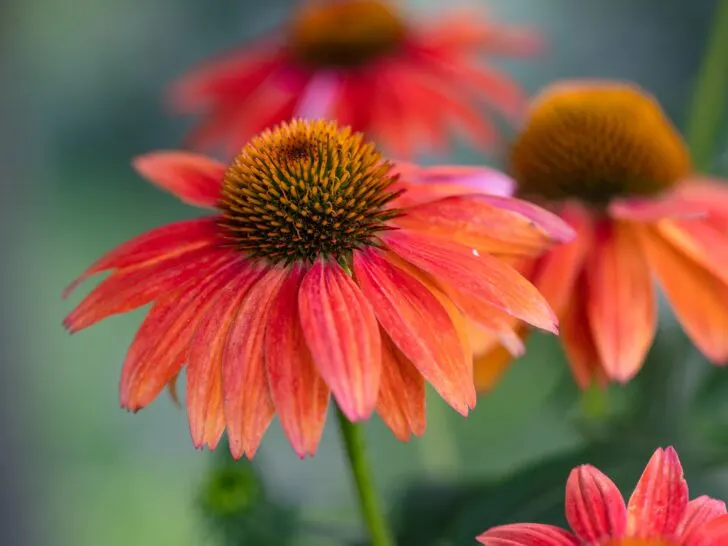
Another member of the daisy family, the orange coneflower is a stunning addition to any garden. Coneflowers grow best in gardening zones 3-9 during the summer months. The coneflower’s most well-known color is purple, but the orange flower is still widely grown.
Also, deer are more likely to leave coneflowers alone, making them a perfect garden flower. Despite deer hating the flowers, pollinators greatly enjoy them.
The vibrant flowers originated from North America and were often used by the indigenous people. Fields of the flowers are found in prairies and meadows. Coneflowers also signify healing and wellness.
24. Butterfly Weed

Butterfly weed is a species of milkweed native to North America. As the name suggests, the weed attracts butterflies with its tiny orange flowers. In addition, this perineal is excellent for attracting helpful insects and hummingbirds.
Despite the plant’s vibrant floral display, it’s mildly toxic to humans and animals. Butterfly weed grows well in gardening zones 3-9 during the summer. The plant prefers mild climates and plenty of sunshine.
This milkweed symbolizes freedom and dignity. However, butterfly weed is often considered invasive since its seed pods spread rapidly. Luckily, animals like rabbits can cull unwanted plant growth.
25. Carnation

Carnations are typically grown in the floral industry due to their vibrant petals and potent fragrance. A bouquet of carnations makes a great gift as they signify love and affection. The flowers are also commonly dyed for holidays since their stems readily absorb color.
The carnation is native to the Mediterranean and has been around for over 2000 years. Carnations are easy to grow, especially in gardening zones 7-8. However, the flowers don’t enjoy extreme heat.
Carnations, or Dianthus Caryophyllus, name descends from Greek and Latin words. Thus their name means divine flower crown. These stunning flowers grow in various exciting colors, including an orange coral color.
26. Iris

Iris Germanica, also known as the orange harvest, is a stunning flower. Typically Irises are purple, but there are other vibrant variations, such as orange. The blooms are known for being showy and highly fragrant.
The Iris flower is extremely old and appears to have originated across Europe and Asia in the middle ages. The stunning flowers have since become a popular ornamental flower for gardeners.
Additionally, many Iris flower roots and leaves are mildly toxic. Therefore, skin irritation is expected when handling the plants without gloves. However, the floral industry still uses plants in bouquets.
27. Mexican Sunflower

Though the Mexican sunflower is native to Mexico and Central America, the flower also thrives in the Southwestern United States. Rather than looking like sunflowers, these plants look more similar to daisies.
Typically, these plants are found in an array of orange and yellow colors. Mexican sunflowers thrive in warm climates and are highly resistant to hot weather. Generally, these flowers prefer to grow in gardening zones 9-11.
The Mexican sunflower will return like a perineal if you live somewhere warm. However, if planted somewhere with cold winters, the plant will die off and need replanting. The flowers symbolize loyalty and adoration, making them a great token of friendship.
28. Globe Amaranth

Globe amaranth, also known as Globosa Gomphrena, has tiny rounded flower buds. However, the plant’s primary purpose is decorative, though it’s consumable. The plant was often used for medicinal purposes by old practitioners.
Some people still grow globe amaranth for antioxidant-rich tea. This Amaranth originated in Central America. However, it grows extremely well in gardening zones 2-8, making it tolerant of cold once well established.
Because of the plant’s unique ball-like flowers, it’s said to symbolize immortality and endless love. The reason for such a symbolization could be the plant’s ability to be dried and stored easily.
29. Bulbine

The bulbine plant can primarily be located in South Africa and Australia. However, it can undoubtedly tolerate humid climates like that of Florida. In addition, the plant is highly tolerant of dry weather.
Bulbine plants also produce tiny yellow or orange flowers that protrude from a stalk out of a grassy base. The grass portion of the plant stays relatively close to the ground, but the stalk can nearly reach 2 ft (60 cm). Aesthetically, the plant is quite leggy, and its vegetation sparse.
Additionally, bulbines enjoy ground that is sandy and near a water source. The plant is also used for medicinal purposes to treat things like low testosterone and to improve fertility.
30. Crown Imperial
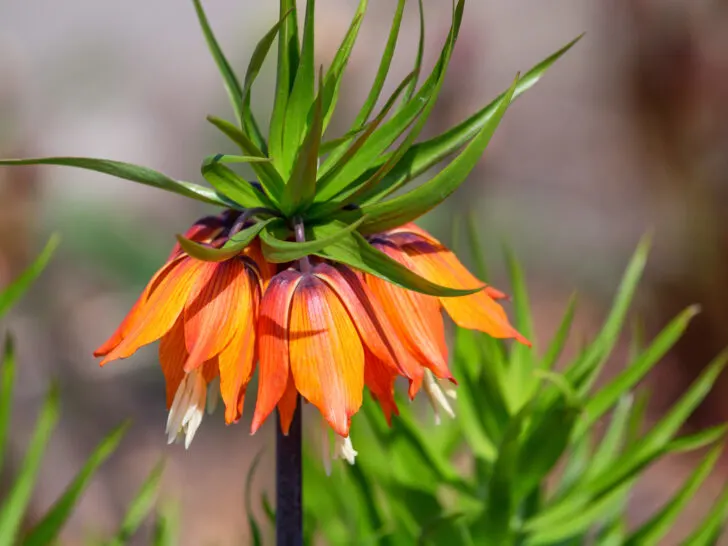
Scientifically known as Fritillaria Imperialis, the crown imperial appears as tiny orange bells hanging from a stalk. The flowers are native to the Middle East and can also be found in West Asia.
The bell-like flowers get their name from how they sit in a circle at the top of their stalk. The flowers form a crown and appear quite regal. These stunning perennials pop up in the spring and prefer gardening zones 5-9.
Crown imperials enjoy sandy soil and are surprisingly resistant to cool weather. Unfortunately, plants are highly toxic to humans and animals. Therefore, gardeners should avoid planting near livestock.
31. Flowering Maple

Another stunning orange bloom is the flowering maple. These plants prefer climates like where they originate, like Africa, Asia, and Australia. The beautiful flowers prefer the growing conditions of gardening zones 8-9.
Flowering maples do well as indoor and outdoor plants so long as their soil and water needs are met. The maple flowers are attractive as they hang downward like tissue paper bulbs. Eventually, the flowers open completely to reveal a stunning bell-like flower.
Additionally, the large leaves can irritate human skin, though not precisely toxic. The plant’s leaves appear similar to grape plant leaves, though much larger. However, the flowers themselves can be eaten and are said to have a sweet flavor.
32. Chinese Lantern

Alkekengi Officinarum and bladder cherry are other names for the Chinese lantern plant. This stunning orange-flowered plant is actually in the nightshade family. The plant derives its name from its lantern-shaped flowers hanging from its stems.
Chinese lantern plants are hardy perennials that grow in small clumps near the ground. The plant technically flowers in the summer, but they don’t develop their bright orange colors until the fall. The lantern grows rapidly and will easily flower after a season of growth.
As the name suggests, the plant is native to Asia and Europe. The plant grows well in gardening zones 3-9. However, cool weather will cause the Chinese lantern to die immediately.
33. Sneezeweed

The sneezeweed derives its name from its being an ingredient in snuff. During medieval times, snuff was used to make a person sneeze, expelling unwanted evil spirits. However, today the plant is primarily used as an ornamental flower or just wild.
The flower appears similar to daisies with bright petals splayed toward the sky. Sneezeweed is thought to originate in North America. The plant pops up in the spring favoring meadows and prairies.
Sneezeweed often sprouts up in the wild, but some gardeners opt to grow the pretty flowers in gardens. When the plants die in the winter, the flowers appear more similar to dried-up sunflowers.
34. Kangaroo Paw

A member of the bloodwart family, the kangaroo paw is a unique flowering plant. As the name suggests, the plant hails from Australia. The plant appears as a grassy bush with tall stalks protruding with orange flowers.
The blooms are relatively small and closely resemble the paw of a kangaroo, hence the name. The plants themselves don’t require much care and are fast growers. Additionally, the plant is often used in floral arrangements due to the tuber-like flowers.
Kangaroo paw or cat’s paw grows well in gardening zones 10-11. The plant enjoys the heat and suffers in colder climates. However, the plant is tolerant of mild humidity despite preferring dry climates.
35. Blackberry Lily

Blackberry lilies are stunning flowers known for pale orange petals dotted with dark orange speckles. Other common names for this flower are the leopard lily and iris domestica. Additionally, the unique plant is native to Eastern Russia, Japan, and China.
Technically, the flower is a member of the iris family. However, once the lily flowers die, an arrangement of shiny black seed pods is left. The seeds resemble that of rattlesnake rattles. These pods eventually break open, wedding for new flowers the following year.
Blackberry lilies require well-draining soil and adequate sunlight to grow. Typically, the flowers grow best in gardening zones 5-10. However, since the lily is a perennial, it will grow back each year.
36. Crocus

Crocus is a low-growing flower that is similar in appearance to tulips. The stunning flowers typically bloom from late winter to early spring. Additionally, the flowers are native to Europe and the Mediterranean.
Something unique about crocus plants is they close up at night. Also, plants are often used to dye things or as medicine. For example, the plant is often used to treat arthritis and gout. However, the plant is toxic and cannot be consumed in large doses.
The flowers come in several colorations, including orange. During the end of winter, the flowers can often be seen peeking from the snow, a signal of spring.
37. Wallflower

Though technically a member of the cabbage family, wallflowers appear as thick shrubbery. The tiny orange flowers pepper the plant, nearly covering its entire surface. Additionally, the flowers lay entirely open and reach toward the sun.
The flower’s scientific name is Erysimum. Wallflowers derive their name from their ability to grow on irregular surfaces like walls, fences, and cement. The plant can adhere and grow if there’s a crack or porous surface.
Wallflowers hail from Europe but grow well in gardening zones 6-10. The stunning flowers are capable of blooming during the spring, summer, and fall. Also, the fragrant plants are considered low maintenance making them a stunning addition to any garden.
38. Hawkweed

Hawkweed appears similar to a dandelion and is related to the weed. The tiny wildflowers splay out toward the sun in a fan shape, like a dandelion, except these are orange.
Though technically a weed, the flowers are quite beautiful. However, most gardeners don’t willingly grow this plant in their yards. The seeds spread quickly and can easily get out of hand.
The plant is native to Europe but was introduced to the United States in 1828 as a decorative plant. As a result, orange hawkweed is protected across several regions in Europe. The protection comes despite the plant taking over unsuspecting lawns with ease.
39. Anthurium

Orange Anthurium or laceleaf are strange plants. The heart-shaped flowers almost appear waxy or plastic with a strange comb-like protrusion. These unique flowers often appear in floral arrangements due to their stunning looks.
The plant is highly toxic and requires medical attention if swelling occurs in the mouth or throat. Anthurium is native to Colombia and Ecuador but can be found in humid tropical climates.
Symbolism-wise, the flower represents hospitality. So the flowers are often gifted to people who are ill or as a housewarming present.
40. Cockscomb

The scientific name for cockscomb is Amaranthaceae. Cockscomb can be found in Africa, Asia, and North and South America. The plant’s name means “burning” in the ancient Greek language. The cockscomb flowers are strange as they grow in swirling patterns, mimicking fire or a brain.
Cockscomb petals almost appear furry rather than soft and flower-like. These plants thrive during the summer and fall in garden zones 9-12. Typically, the plants are low maintenance to grow so long as cold weather is avoided.
Regarding the meaning behind the flower, the cockscomb is often thought to represent affection. Therefore, the plant is highly cultivated in places like China.
41. Pocketbook Plant

The pocketbook plant (Calceolaria) is often referred to as lady’s purse or slipper wart. These flowers are unique and bulbous in shape. They tend to be the primary color–like orange–and have dark splotches across their petals.
Pocketbook plants originate from Central and South America. The flowers are annual but generally considered hardy. Additionally, these plants pop up in early spring.
These plants prefer indirect sunlight and cooler weather. Because of their unique light and temperature needs, they typically grow well indoors. Additionally, pocketbook plants are often available for purchase for Valentine’s Day gifts.
42. Pincushions

As the name pincushion suggests, these flowers are large and round. The orange variation is often referred to as the “flame giant.” This pincushion originates from South Africa and enjoys similar climates.
Orange pincushions are large, reaching nearly 6 ft (182 cm) in height. Typically the plant is considered a shrub. However, pincushions often add dramatic flare to a garden space.
43. Star Flowers

Star flowers are star-shaped. Also known as Ornithogalum Dubium, the star flower petals are pointed, creating a star-like appearance. Additionally, the petals are waxy with a laminated shine, as are the leaves.
The Star Flower plant originates from South Africa and typically enjoys warmer gardening zones like 7-11. However, it’s important to note that star flowers need well-draining soil or are susceptible to root rot.
Symbolism-wise, these orange star flowers represent innocence and forgiveness.
44 Goldfish Plant

The exotic and eye-catching Goldfish plant is an easy-to-care-for evergreen houseplant. Also known as Columnea nematanthus. Their orange blooms resemple a leaping goldfish.
Native to Central and South America, this plant is a vining epiphyte that grows in rainforests on the branches of trees and rocks, providing it with a unique and aesthetically pleasing look.
45. Morning Glory

Finally, there is the morning glory flower, which is a vine. Typically, the plants come in white or purple shades. However, an orange variety of the vine does exist.
The orange morning glory produces tiny orange flowers along a vine.
The vine is native to Mexico and will return annually. Since then, the flowers have spread, even becoming like weeds in some regions of the US. They spread well in warm climates and need plenty of sunlight to bloom.
Morning glories symbolize hope and strength because of their resilience. In addition, they are considered reliant because the little flowers often grow despite harsh conditions.
Frequently Asked Questions
Next, I’ll go over some frequently asked questions about orange flowers.
There are over 100 orange flowers. Most flowers have orange variations like roses, daisies, and other wildflowers. Orange flowers occur naturally and through cross-pollination until the desired coloration occurs. Orange flowers are less common than white, purple, or red flowers.
There are orange daisies known as African daisies. These flowers are bright orange in color and appear simpler in shape than small sunflowers. Orange daisies are medium-sized perennials with deep purple centers. The plants are also used heavily in florist shops for bouquets.
Orange flowers symbolize excitement and enthusiasm and are often given as gifts to express warmth and happiness.
Conclusion
There are hundreds of orange flowers worldwide, though I just went over 45 of the most popular ones today. More have been created in recent years as the demand for orange flowers is rising. You can find orange variations of almost any flower nowadays, especially in flowers used for floral arrangements.
Orange flowers make a stunning addition to any garden. You can easily acquire an orange flower for your specific gardening zone.
Other Articles You May Be Interested in
37 Yellow Flowers For Your Home Or Garden
51 Beautiful Types of White Flowers
59 Beautiful Types of Blue Flowers

